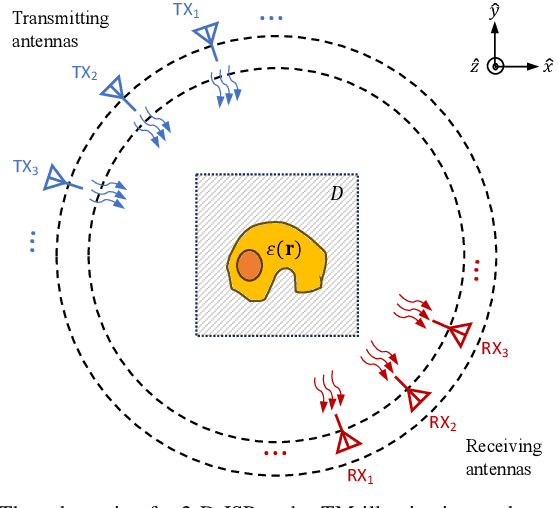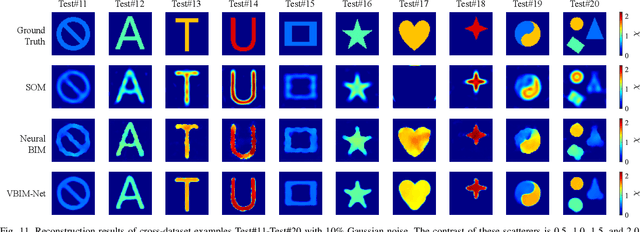Zhun Wei
VBIM-Net: Variational Born Iterative Network for Inverse Scattering Problems
May 29, 2024



Abstract:Recently, studies have shown the potential of integrating field-type iterative methods with deep learning (DL) techniques in solving inverse scattering problems (ISPs). In this article, we propose a novel Variational Born Iterative Network, namely, VBIM-Net, to solve the full-wave ISPs with significantly improved flexibility and inversion quality. The proposed VBIM-Net emulates the alternating updates of the total electric field and the contrast in the variational Born iterative method (VBIM) by multiple layers of subnetworks. We embed the calculation of the contrast variation into each of the subnetworks, converting the scattered field residual into an approximate contrast variation and then enhancing it by a U-Net, thus avoiding the requirement of matched measurement dimension and grid resolution as in existing approaches. The total field and contrast of each layer's output is supervised in the loss function of VBIM-Net, which guarantees the physical interpretability of variables of the subnetworks. In addition, we design a training scheme with extra noise to enhance the model's stability. Extensive numerical results on synthetic and experimental data both verify the inversion quality, generalization ability, and robustness of the proposed VBIM-Net. This work may provide some new inspiration for the design of efficient field-type DL schemes.
Non-line-of-sight reconstruction via structure sparsity regularization
Aug 05, 2023Abstract:Non-line-of-sight (NLOS) imaging allows for the imaging of objects around a corner, which enables potential applications in various fields such as autonomous driving, robotic vision, medical imaging, security monitoring, etc. However, the quality of reconstruction is challenged by low signal-noise-ratio (SNR) measurements. In this study, we present a regularization method, referred to as structure sparsity (SS) regularization, for denoising in NLOS reconstruction. By exploiting the prior knowledge of structure sparseness, we incorporate nuclear norm penalization into the cost function of directional light-cone transform (DLCT) model for NLOS imaging system. This incorporation effectively integrates the neighborhood information associated with the directional albedo, thereby facilitating the denoising process. Subsequently, the reconstruction is achieved by optimizing a directional albedo model with SS regularization using fast iterative shrinkage-thresholding algorithm. Notably, the robust reconstruction of occluded objects is observed. Through comprehensive evaluations conducted on both synthetic and experimental datasets, we demonstrate that the proposed approach yields high-quality reconstructions, surpassing the state-of-the-art reconstruction algorithms, especially in scenarios involving short exposure and low SNR measurements.
 Add to Chrome
Add to Chrome Add to Firefox
Add to Firefox Add to Edge
Add to Edge